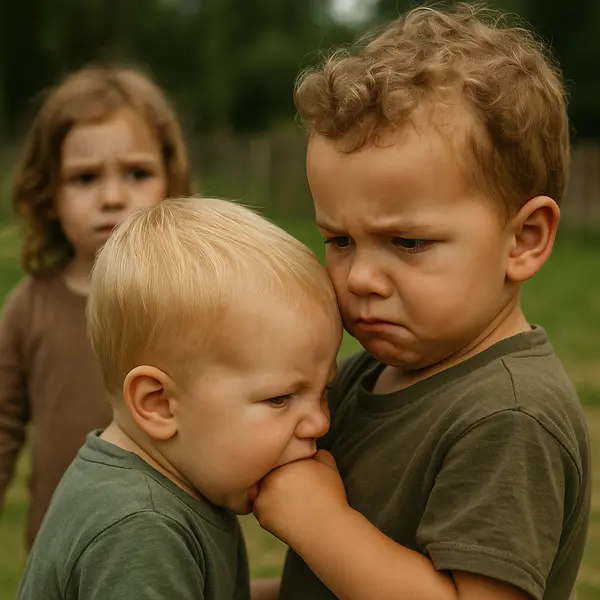- Why Do Kids Bite Other Kids?
- Strategies to Prevent and Respond to Biting
- Building Positive Behavior in Children
- A Final Word on Biting and Behavior
Why Do Kids Bite Other Kids?
Understanding the Behavior: Why Do Kids Bite Other Kids?
Why do kids bite other kids? This question often arises when toddlers suddenly lash out with their teeth. While the behavior can be alarming, it is usually a normal phase in early childhood development. Understanding the motivations behind it helps caregivers respond effectively and compassionately.
Biting behavior is most common between the ages of 1 and 3, a period when children are developing emotional expression, social navigation, and sensory regulation. According to the Center on the Social and Emotional Foundations for Early Learning, young children frequently bite due to limited communication skills, frustration, curiosity, or teething discomfort.
Developmental Reasons Kids Bite
- Teething and Sensory Exploration: Biting may soothe sore gums or satisfy oral-motor needs.
- Limited Language Skills: Toddlers often bite to express emotions they can’t yet verbalize.
- Curiosity and Experimentation: Children explore cause and effect through their actions.
- Impulse Control Issues: With underdeveloped self-regulation, young children may act out strong emotions like anger or excitement.
Environmental Triggers
- Overstimulation or crowding
- Changes in routine
- Fatigue or hunger
- Toy-related disputes or attention-seeking
In group settings, environmental stressors like noise or lack of space can increase the likelihood of biting. Therefore, it’s important to identify and address these triggers proactively. Additionally, recognizing patterns can help prevent future incidents.
Strategies to Prevent and Respond to Biting
Preventing Biting
To prevent biting, consider the following:
- Stick to predictable routines for meals, naps, and play, as predictability can reduce stress.
- Offer teething-friendly toys to satisfy oral needs and provide relief when discomfort arises.
- Reinforce positive behaviors through praise and redirection, which encourages better habits over time.
- Monitor group play closely so that you can intervene early if tensions arise or emotions escalate.
Responding When a Child Bites
When biting occurs, it’s essential to act quickly and effectively:
- Stay calm and composed. Use a firm tone and clear language: “No biting. Biting hurts.” This shows consistency and authority.
- Comfort the child who was bitten first. This prevents reinforcing the behavior by giving attention to the biter and teaches empathy.
- Guide the child who bit to understand the consequence of their actions: “You were mad, but we use words, not teeth.” This fosters accountability and builds emotional vocabulary.
- Avoid labeling a child as a “biter,” which can lead to stigmatization and recurrence of the behavior. Instead, focus on teaching better coping strategies.
Working with Caregivers and Teachers
Since children interact in multiple environments, consistency is key. Therefore, share observations, triggers, and strategies with teachers or other caregivers to ensure a unified and effective approach. Working as a team maximizes positive outcomes.
When Professional Help is Needed
Although most biting is developmental, if it continues past age 4 or escalates in severity, consult a pediatrician or child psychologist. Persistent biting may reflect deeper emotional or developmental issues, so early intervention is beneficial.
Building Positive Behavior in Children
Teaching Emotional Awareness
Children need support to understand and manage their emotions. You can:
- Help children label their feelings: “You look upset because your toy was taken.” This builds emotional literacy and improves communication.
- Encourage alternatives to biting: “Say, ‘That’s mine,’ or ask an adult for help.” Providing scripts empowers children to respond constructively.
- Provide outlets for strong emotions, like sensory toys or movement activities. These help redirect excess energy or stress in a healthy way.
Encouraging Positive Behavior
To foster positive behavior:
- Praise appropriate emotional responses: “Great job telling your friend how you feel.” This reinforces good habits and builds self-esteem.
- Use children’s books to illustrate kind behavior and the consequences of biting. Stories can make lessons more relatable and memorable.
A Final Word on Biting and Behavior
In conclusion, biting can be distressing, but it is a natural and often temporary stage in child development. Therefore, understanding why do kids bite other kids equips parents and caregivers with the knowledge to respond thoughtfully. With patience, empathy, and consistent guidance, children can learn to express themselves in healthy, respectful ways. Ultimately, what matters most is nurturing positive communication skills and emotional regulation.
The following post may interest you
Croup Cough: Understanding and Managing It in Children
Sources
Biting Among Toddlers and Twos: Responses to Try
https://www.exchangepress.com/library/5018201.pdf
Biting versus Chewing: Eating Style and Social Aggression in Children
https://www.sciencedirect.com/science/article/pii/S1471015314000397
Bodies and Bites: a medical school program that teaches anatomy, physiology, and nutrition to elementary school kids
https://www.frontiersin.org/journals/public-health/articles/10.3389/fpubh.2024.1398124/full

